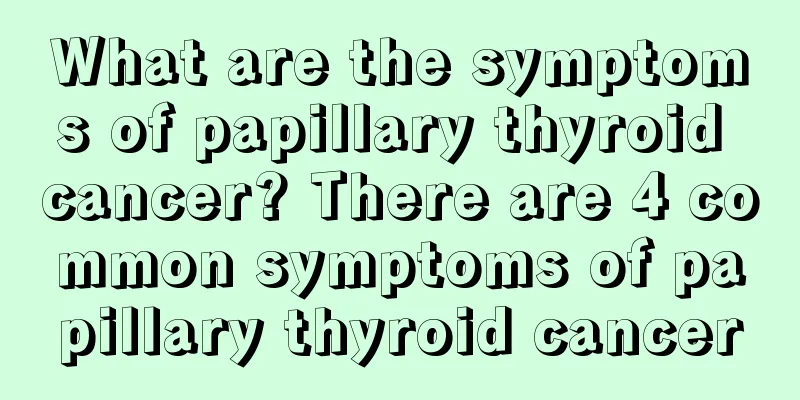What are the symptoms of papillary thyroid cancer? There are 4 common symptoms of papillary thyroid cancer

|
Thyroid cancer is a very common endocrine malignancy that originates from the thyroid epithelial cells. Most of its pathological types are differentiated thyroid cancer, including papillary adenocarcinoma and follicular adenocarcinoma. If differentiated thyroid cancer is treated properly, the prognosis is very good, with a 10-year survival rate of more than 90%. Papillary carcinoma is more common in clinical practice among thyroid cancers. Papillary thyroid cancer is the most common and the least malignant. It accounts for about half of thyroid cancers and is more common in children or young (before 40 years old) female patients. Some patients have undergone neck X-ray treatment in childhood. The tumor grows slowly and can be confined to the thyroid gland for several years. The lesion can spread from the primary site to other parts of the gland and local lymph nodes through the intraglandular lymphatic vessels, or it can be confined for several years, so its nature is easy to be ignored. Symptoms in the middle and late stages 1. Symptoms of local metastasis: In the late stage of thyroid cancer, local metastasis often appears as hard and fixed lymph nodes in the neck. Clinically, papillary thyroid cancer and medullary thyroid cancer are more likely to have metastasis and enlarged lymph nodes in the neck. 2. Local compression symptoms: In the late stage of thyroid cancer, the thyroid tumor continues to swell and may compress the recurrent laryngeal nerve, causing the patient to experience hoarseness, invade the esophagus, cause dysphagia and weight loss, and invade or compress the trachea, causing dyspnea, hemoptysis and chest discomfort. 3. Symptoms of distant metastasis: The rate of metastasis of thyroid cancer in the late stage can reach 50% to 90.5%, and the rate of cervical lymph node metastasis is 64.56%. Distant metastasis of thyroid cancer is often seen in the lungs, skull, vertebrae and pelvis. Brain metastasis can cause headaches and vomiting, lung or mediastinal metastasis can cause coughing, hemoptysis and chest discomfort, bone metastasis can cause pathological fractures and cause pain, spinal cord metastasis can cause numbness or weakness in the hands and feet, etc. 4. Associated symptoms: Patients with medullary thyroid cancer may also have pheochromocytoma and parathyroid hyperplasia or tumors. Clinically, they may experience symptoms such as diarrhea, palpitations, facial flushing, and hypocalcemia. Therefore, if the above symptoms occur, you should go to a regular hospital for treatment in time. With the continuous maturity and development of medical technology, having thyroid cancer does not mean a death sentence. Choosing the correct and appropriate treatment method combined with biological cell immunotherapy, it is still possible to achieve clinical cure for patients with advanced thyroid cancer. |
<<: Is papillary thyroid cancer contagious? What are the factors that may cause infection?
>>: What are the early symptoms of medullary thyroid cancer? How to treat medullary thyroid cancer
Recommend
Is it normal to peel off the skin after using medicine to remove spots
Although laser freckle removal surgery is the mos...
How long can you live after laryngeal cancer treatment
Laryngeal cancer is a malignant tumor that occurs...
What are the functions of active peptides
I'm sure not everyone is very familiar with a...
What medicine is better for nasal mucosal edema
Patients with nasal mucosal edema must pay attent...
Can you eat too many dried persimmons?
Some people stay away from persimmon cakes, while...
How many causes are there for lung cancer? 5 causes are very likely to induce lung cancer
Many people think that only smokers will get lung...
How to remove oil stains from clothes
Everyone changes and washes clothes every day. Th...
What are the symptoms of advanced liver cancer? Four essential examinations to prevent liver cancer
You must know these facts about liver disease The...
Can stretching help you grow taller?
In order to make themselves taller, people now lo...
Why do I feel uncomfortable and sweating?
Some people often feel uncomfortable, sometimes a...
What are the symptoms of chronic enteritis?
Many people initially suffer from acute enteritis...
Can mugwort cure hemorrhoids?
Hemorrhoids are often not very serious in the ear...
Does bone cement have any side effects? What is the significance of bone cement to the human body?
Bone cement is used to repair trauma and fill dis...
What is the effect of tanshinone injection
I hope everyone can understand that when using an...
What is the current situation of fibroids
With the improvement of living standards, fibroid...









